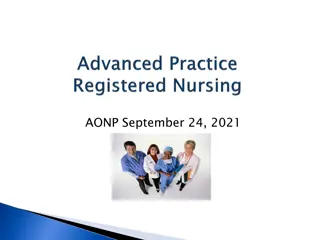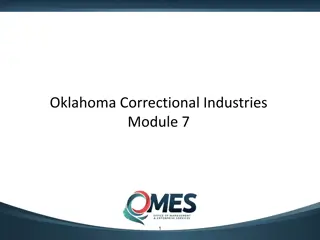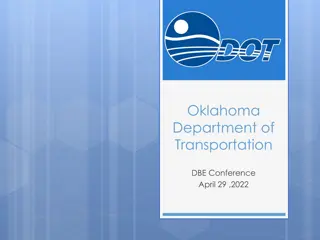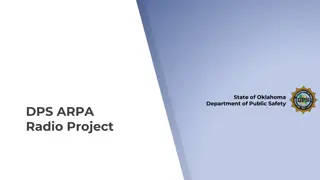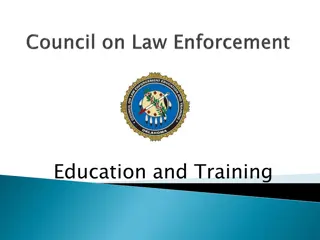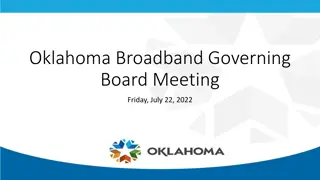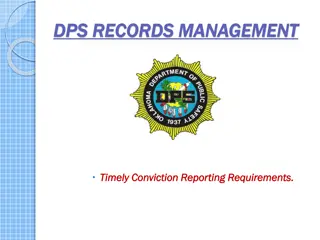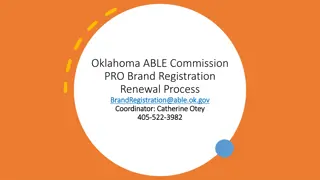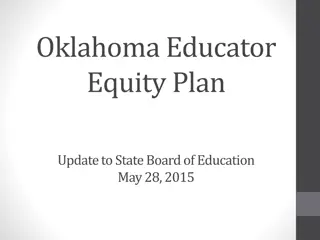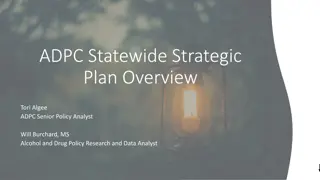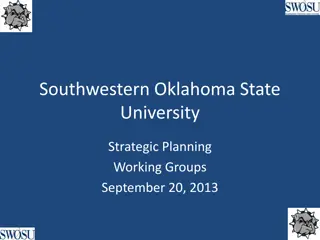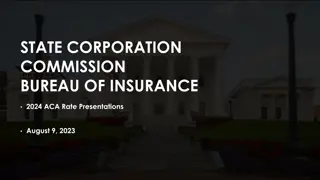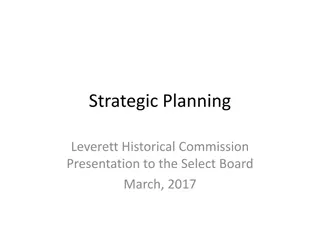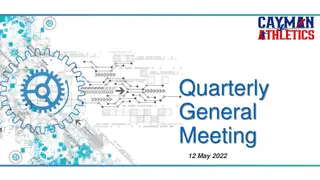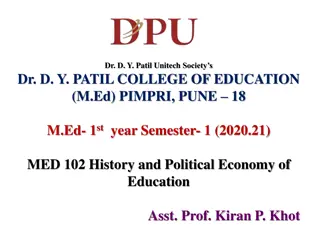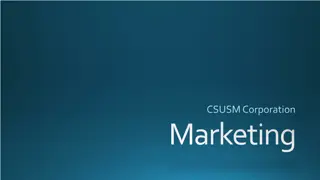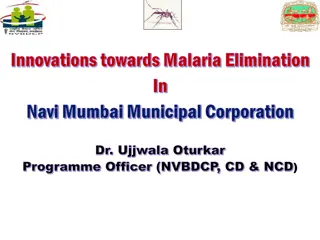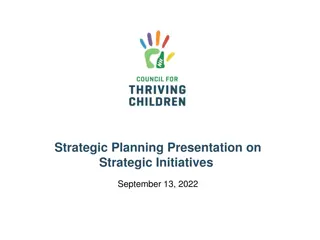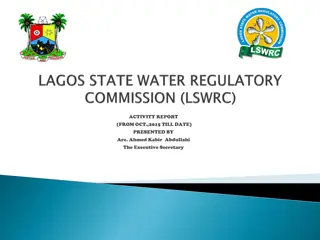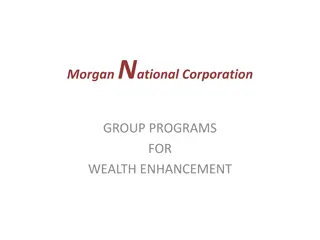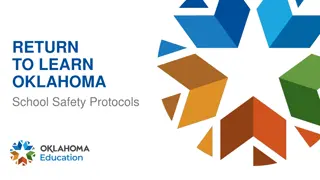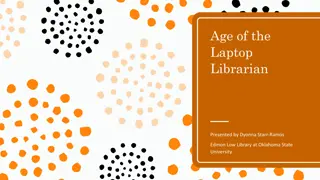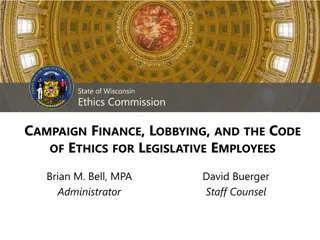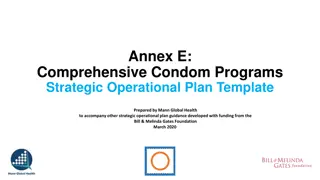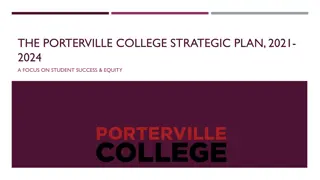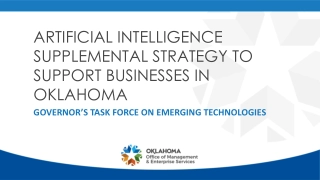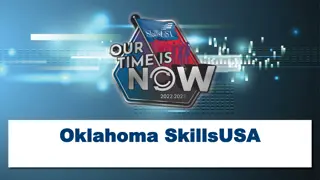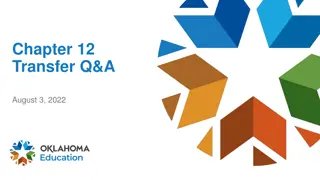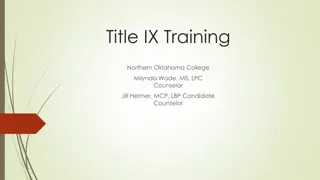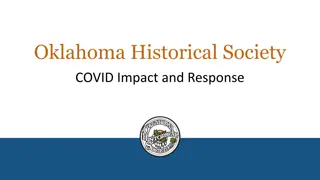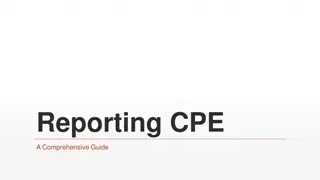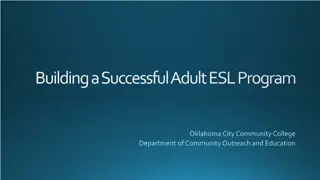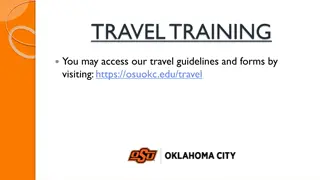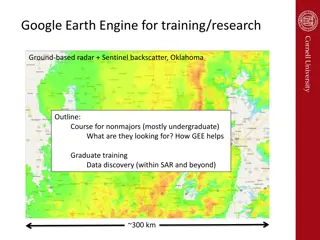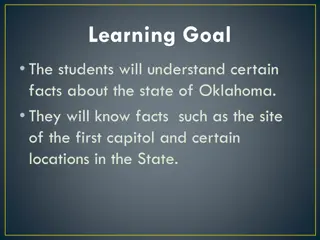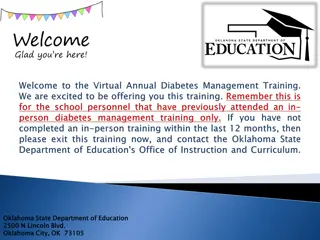Oklahoma Corporation Commission Strategic Plan FY 2023-28 Overview
The Oklahoma Corporation Commission (OCC) plays a vital role in regulating various industries in Oklahoma, ranging from oil and gas to utility services. With a focus on responsible resource development and protecting the environment, the OCC aims to balance the rights of the public and regulated entities. Their strategic plan emphasizes teamwork, customer service, accountability, and innovation to achieve their vision and mission effectively.
Download Presentation

Please find below an Image/Link to download the presentation.
The content on the website is provided AS IS for your information and personal use only. It may not be sold, licensed, or shared on other websites without obtaining consent from the author. Download presentation by click this link. If you encounter any issues during the download, it is possible that the publisher has removed the file from their server.
E N D
Presentation Transcript
Oklahoma Corporation Commission Strategic Plan FY 2023-28 October 1, 2022 Submitted by: Brandy L. Wreath, Director of Administration/Appointing Authority
Agency Introduction The Oklahoma Corporation Commission (OCC) is charged with balancing the rights and interests of Oklahoma residents and industries. The Commission regulates a wide range of activities in four core program areas: (1) Oil and gas drilling and production; (2) Public utility and telecommunications; (3) Motor carrier, rail, underground natural gas storage and pipeline transportation; and (4) Petroleum storage tanks. Founded in 1907 by Article 9 of the Oklahoma Constitution, this agency now includes the following divisions: 1. Oil and Gas Conservation Division 2. Petroleum Storage Tank Division 3. Public Utility Division 4. Transportation Division 5. Administrative, Judicial and Legal Services The OCC develops and enforces regulations that affect approximately 359 public utilities; 8,400 motor carriers and 4.5 million trucks; 2,524 oil and gas operators; and 4,200 motor fuel facilities. It is responsible for overseeing broadband service funding to approximately 550 school districts, 180 libraries and 305 healthcare providers. Additionally, the agency oversees the operation of approximately 154,391 active oil, gas and underground injection wells; 50,000 miles of natural gas and hazardous liquids pipelines; 13 underground natural gas storage facilities; 170,000 miles of electric distribution lines; 10,500 petroleum storage tanks; 45,000 motor fuel dispensers; and 3,470 railroad crossings.
Agency Vision, Mission, and Values Vision: To be a trusted, effective agency that works collaboratively with industry and consumers to accomplish its Mission in a way that protects people and the environment, ensures responsible development of natural resources, improves quality of life, promotes continued economic development, and holds both itself and the industries it regulates accountable to the residents of Oklahoma. Mission: Empowering Oklahoma by: ensuring responsible development of oil and gas resources; safe and reliable utility services at fair rates; safe and legal operation of motor carriers, pipelines, railroad crossings, and fueling stations; timely licensing and registration of commercial motor vehicles; preventing energy-related pollution of the environment; while balancing the rights and interests of the public with those of regulated entities through development and enforcement of regulations in an open, transparent, ethical, and just manner. Core Values: 1. Teamwork: We strive for diversity and inclusion in all ways. Success depends on all of us. We strive to take care of ourselves, care for those around us, and support others across the agency. We seek to maintain a positive, supportive, balanced, and healthy workplace for all employees. 2. Customer Service: We are all the face of the agency; our actions affect our collective reputation. We are here to serve people solve problems with service in mind. 3. Accountability: We enforce the rules and statutory mission of the agency. We support our commissioners and empower them to represent all Oklahomans by being accountable. We are good stewards of the resources entrusted to us. We are accountable for our actions and how they affect others. If we see an unsafe or illegal act, it is our job to take action. 4. Innovation and Improvement: We are willing to embrace change. We are willing to teach and learn new skills. We learn from our past, embrace the present, and innovate for the future. We don t let the perfect become the enemy of progress.
Section I: Section I: Agency Agency Environment Environment Groups served by the agency Expected changes in service Expenditures, Budget & FTE Total Labor Spending Appropriations 4
Groups of People Served by the Agency Group Served Services Received Estimated Changes in Group Served (within next 5 years) Rate-regulated utilities can offer safe and reliable service at affordable rates, while ensuring the company's viability. Disputes between regulated utilities and their customers can often be resolved with OCC Consumer Services acting as unofficial intermediaries. OCC also works to ensure safety compliance which benefits utilities and their customers alike. Alternative technologies such as wind and solar energy, electric vehicles, battery storage, hydrogen, and renewable natural gas are expected to continue to grow, posing new challenges for utilities and their customers. New technologies will offer improvements in services provided, both to utilities and their customers. Electric and Natural Gas utilities and their customers 1 Public school districts, public libraries, and eligible healthcare providers may seek support from the OUSF to pay up to 100% of the cost of high- speed broadband connections to those facilities. Through its primary universal service support, the OUSF makes reasonably comparable services available in rural areas, at affordable rates, as in urban areas. By its operation, the OUSF supports the availability of critical network facilities that are integral to furthering economic development in rural Oklahoma. Further recognition that the OUSF mechanism ultimately supports either broadband services directly or networks that are capable of, and necessary for, the delivery of broadband capabilities. As Oklahoma s efforts to expand broadband deployment ramp-up (see State Broadband Office) for the benefit of un-served and under-served Oklahomans, the OUSF will have a role to consider in developing those additional broadband deployment goals and processes for those providers. Public School Districts, Public Libraries, Healthcare Providers, Rural Telephone Companies 2 Petroleum Storage Tank owners and customers of retail fueling outlets, PST licensees (installers, removers, consultants, etc.) Fuel Specialists assist tank owners and operators with understanding their system and provide consumer protection through octane checks and calibrations. PST's reimbursement programs assist tank owners when a release occurs from their tank system and reimburses corrective actions at sites meeting specific requirements. 46% of the tanks in Oklahoma are over 30 years old. For many owners and operators in rural areas, if a tank leaks, the cost to upgrade the system is prohibitive without financial assistance, leaving some communities without a location to buy fuel. Staff and stakeholders will continue to collaborate on initiatives to meet the needs of rural operators and provide win-win results. 3 Motor Carriers are served by Transportation staff providing guidance and issuance of credentials to ensure legal operation within the State of Oklahoma and throughout the U.S., depending on their individual business needs. Through size and weight enforcement, Motor Carriers are able to operate with higher confidence that all carriers are operating within regulatory safety standards, and that damage to the infrastructure is mitigated. Motor Carriers (commercial cargo, moving services, passenger carriers) Commercial vehicle traffic is expected to increase over the next 5 years in Oklahoma. Along with the anticipated industry growth, the OCC must be prepared to serve all new stakeholders. 4
Groups of People Served by the Agency Group Served Services Received Estimated Changes in Group Served (within next 5 years) Implementing electronic permitting will allow staff to process more quickly and efficiently, allowing operators to save time and money. Improved information management systems will allow easier access to data critical to conducting business. Permitting and compliance services; data services; assistance in field operations; liaison with surface and mineral owners. 5 Oil and Gas operators Safety inspections; operator training; incident investigation; excavation damage prevention liaison to federal pipeline regulators. Aging pipeline infrastructure in Oklahoma will increase demand for services. Expected increase in small pipeline operators will increase training demand. 6 Pipeline operators Research and education; explaining documents/rules/statutes; facilitating communication between mineral owners/surface owners and oil and gas industry. Mineral owners need for assistance is expected to grow as consolidation in the oil and gas industry, horizontal well development, and reworking old vertical wells continues, and with the introduction of new technologies such as hydrogen that are in the beginning stages. 7 Mineral Owners Surface owners and others in areas needing remediation Investigation and remediation. Well plugging of abandoned wells through state funds well plugging program. There will be increased activity due to the inflow of Federal funds from the IIJA grant. 8 Venue for review, approval and public engagement in crossing changes and closures, as well as other issues related to crossings. Mediate disputes between municipalities and railroads. The expected increase in the length of trains and an expected increase in miles traveled are expected to increase case load and issues related to crossing issues. 9 Railroads
Analysis of Expected Changes in Services Reason for Change in Services (Statute Name & Statute Reference or Brief Description of Circumstance) Service Changes Expected (Briefly describe expected changes to services and how it will impact citizens/customers and the agency.) The OCC will be administering approximately $25 million in federal grant dollars to plug abandoned wells across the state. This will be done in collaboration with multiple agencies and private industry partners. OCC has issued an RFP for a third-party vendor to assist with grant management. Increased activity in well plugging due to the federal grant program IIJA. 1 The Transportation Division s Pipeline Safety Group will be expanding enforcement of federal rules. 2 The group will be adding eight additional field inspectors due to a change in federal requirements. 3 HB2234 Electric Vehicle Act of 2021 The OCC will continue to develop the procedures related to public EV charging station testing and reporting. 4 Opening of Bryan County Port of Entry Increased motor carrier enforcement activities. IMS Implementation for E-Citations, MOEA, and Surety 5 These systems will make it easier for stakeholders to conduct business online with the OCC.
Total Historic Actual Expenditures (FY 2018-22) and Current Year Budget (FY 2023) Explanation of Significant Changes and Trends Beginning in FY 2018, OCC began agency modernization and digital transformation efforts to address a 20+ year technology debt. Additional appropriations were given to the agency in FY 2020 to support these initiatives. During this timeframe, Transportation also opened a Port of Entry (POE) in Love County in FY 2018 and began recruiting for Bryan County POE to open in fall 2022. Pipeline Safety added eight field inspectors in FY 2023 budget due to new federal laws requiring inspection of traditionally non-regulated gas gathering lines and underground facility damage prevention. *The agency special accounts (24% of budget) include two escrow accounts for mineral owners and surety held for oil and gas operators. These funds cannot be utilized for agency operations; but must budgeted into PeopleSoft to create disbursements. *
Labor Spend Historic Actual Expenditures (FY 2018-22) and Current Year Budget (FY 2023) Explanation of Significant Changes and Trends The most notable changes in FTE during this period is within our Transportation Division, which includes Pipeline Safety. OCC s FTE count began to grow beginning with the opening of Love County POE in FY 2018. Recruitment efforts are currently ongoing for Bryan County POE slated to open fall 2022, resulting in budgeted FTE growth for FY 2023. The division experiences hardship in recruiting for these rural community locations. OCC is proactively utilizing incentives to generate interest in filling vacant FTEs. Full-time Equivalents (FTE) are a calculation based on payroll data, not a headcount. FTE calculations compare staffing levels across agencies.
Appropriation History Five-Year Appropriation History Legislated Appropriation ($) (Include supplemental if applicable.) Fiscal Year $20.0M $17.6M $17.0M $16.9M $18.0M $16.9M FY 2019 $10,628,177 $16.0M $14.0M $12.0M FY 2020 $17,568,600 $10.6M $10.0M $8.0M FY 2021 $16,865,856 $6.0M $4.0M $2.0M FY 2022 $16,876,719 $0.0K FY 2019 FY 2020 FY 2021 FY 2022 FY 2023 $16,964,255 FY 2023 Appropriation Supplemental
Resource analysis Financials Staffing Savings & Efficiencies Goals & strategies Goals & strategies Key Performance Metrics Type of Funding Section II: Section II: Strategic Plan Strategic Plan 11
Financial Resource Analysis Carryover FY 2019 FY 2020 FY 2021 FY 2022 Total appropriated carryover amount expended ($) $0 $145,846 $787,812 $801,078 Historical Cash Balances FY 2019 FY 2020 FY 2021 FY 2022 Year End Revolving Fund Cash Balances (All Revolving Funds) $28,036,504 $30,053,661 $28,954,340 $36,610,295 Revolving Class Fund # (Unrestricted only) #202 Revolving Class Fund Name (Unrestricted only) Current cash balance ($) Corporation Commission Revolving Fund $7,844,462 # $ # $ # $ # $ # $ Total Current Unrestricted Revolving Fund Cash balance: $7,844,462 Unrestricted funds are those that are not limited by state or federal law, rule, regulation, other legally binding method, or donor restriction.
Staffing Trend Analysis FY 2019 FY 2020 FY 2021 FY 2022 FY 2023 Total Budgeted Positions / PINs (#) 575 597 585 588 591 Budgeted Vacant PINs (#) 56 59 47 42 60 Budgeted Vacant PINs ($) $1,601,878 $2,167,998 $2,019,144 $2,021,641 $2,969,220 Budgeted PINs over 6 months Vacant (#) N/A N/A N/A N/A 24 Budgeted PINs over 6 months Vacant ($) N/A N/A N/A N/A $801,310 Headcount* (as of 6/30) 532 550 545 527 N/A Turnover Rate* (%) 12% 8% 9% 11% N/A *Headcount and Turnover Rate data provided by OMES HCM.
Savings & Efficiencies (Current or Planned) FY 2022 (Actual $ Savings) FY 2023 (Projected $ Savings) FY 2024 (Projected $ Savings) Savings or Efficiency Name Brief description of how savings were achieved Savings in Unit of Measurement Reallocated FTE efficiencies gained from WorkDay rollout to support employee metrics for performance evaluations and training rather than increasing FTE. Administrative employees have been embedded in core functions to allow cross-training for critical statutory duties. Employee Cross- Training FTE cross-trained to perform additional functions. $100,000 $200,000 $300,000 Office space has been reduced and optimized by sharing or hoteling spaces, along with combining certain sectionsto encourage faster, more efficient collaboration. This effort will continue over the next 2-3 years with personnel relocation as the Jim Thorpe building renovation begins. Currently estimated 90,000 sq ft of usable OCC space. Approximately 12,000 sq ft down from that over the past year. $200,000+ Depending on building relocation Office Consolidation $75,000 $50,000-$75,000 New IT systems, IMS and WorkDay allowed OCC to reallocate personnel to new requirements once their duties were automated. Additionally, OCC increased internal training opportunities through the use of OCC experts in various fields rather than outsourcing at an additional costs. $65,000 (includes cost of benefits) 1 Accounting Tech reallocated $10,000 on trainings $100,000 3 HR specialists 2 Support staff embedded in divisions $20,000 on trainings FTE Efficiency Through Automation and Available Internal Resources $400,000 As reallocations continue $50,000 on trainings FTE reallocated in lieu of new hires. Examples are HR/Workday, clerks. Potential savings from mitigating risk from attacksare in the thousands of dollars Potential savings from mitigating risk from attacksare in the thousands of dollars Potential savings from mitigating risk from attacksare in the thousands of dollars Server and application upgrades; Expansion of Laserfiche with enhanced customer searches; Improved credit card and ACH payment functionality; and added 24/7 access to Court Filings. Mitigated excess losses due to cyber security and data integrity. Increased/expanded customer service by 66% with 24/7 access. Agency Modernization OCC partnered with multiple agencies on the Hydrogen Task force to develop a statewide goal and plan to become a top 10 state. These collaborative efforts will result in Oklahoma becoming a hub for the critical Hydrogen industry. By collaborating and sharing workload with other agencies, this would reduce the OCC need to increase FTE counts. Partnering with other Agencies Unable to calculate currently Unable to calculate currently N/A
Agency Goals and Key Performance Metrics FY 21 Actuals FY 22 Actuals FY 23 Target FY 28 Target Goal Metric [Major agency goal. Include the name of the agency program if applicable.} [Name of the indicator/ metric used to measure the output and outcome of the goal.] EMPLOYEE DEVELOPMENT: Increase employee satisfaction and engagement ratings Metric: Salary plans in place for 100% of OCC job codes. Goal 25% per quarter till 100% STAKEHOLDER EXPERIENCE: Improve customer experience and interaction Metric: Develop online forms for stakeholders to provide feedback on all areas of OCC operations. Change Management to be responsible for processing action plans. Metric: 3 reports per quarter FINANCIAL REPORTING: Improve reporting by creating simplified reports. Match revenues/expenses in compliance with laws/standards Metric: +/- 10% variance of actual spend compared to budget with reasonable explanation documented outside of variance range 1 Employee Retention N/A N/A 75% 100% Improved Stakeholder Satisfaction 2 N/A N/A 12 12 3 Improved Financial Reporting 6.43% 9.75% 9% 9% IT INVESTMENT: Invest in the development of agency-wide enterprise system and agency's IT infrastructure Metric: Complete all ongoing IMS modules including minimum viable products for Transportation and Oil and Gas Conservation Divisions by September 2023 Metric: Upgrade all 2008 servers to current versions and complete Laserfiche migration agency-wide COMMUNICATION: Internal/external effective and transparent communications Metric: Add requirement on all employees PMPs to conduct or receive a minimum level of communication training appropriate to their job code 25% Phase 1 implemented 50% Phase 2 implemented 4 Agency Modernization 85% 100% 5 Improved Communication N/A N/A 100% 100%
(1) Employee Retention Brief description of major agency goal Recognizing the importance of employee retention to excellent customer service, improve employee satisfaction, health, safety, engagement and retention by showing ongoing appreciation and support for staff, while continuing to develop their skills. Brief description of strategy to achieve the goal 1.1 Complete salary reviews for all OCC salaries to set appropriate compensation levels and position specific expectations. Develop salary plans for each job code. 1.2 Each employee will have a documented development plan on file. 1.3 Expand agency-need and employee-driven training. Indicator or Metric to measure goal progress 1.1 Salary plans in place for 100% of OCC job codes, 25% per quarter till 100%. 1.2 100% employees will have a development plan on file yearly. 1.3 OCC to host a minimum of 3 trainings per month available to all employees, 12 per quarter. Type of $ Resource to be Used Existing cash and efficiencies for first round salary plans. Additional budget requests may be required for future year phases.
(2) Improved Stakeholder Satisfaction Brief description of major agency goal Improve satisfaction by placing employees with enhanced skill sets in the right jobs with appropriate tools and technology, thus creating customer service excellence. Brief description of strategy to achieve the goal 2.1 Issue a stakeholder survey measuring customer experience. Create baseline, then track progress. 2.2 Develop online forms to expand ability of stakeholders to provide feedback on all areas of OCC operations. 2.3 Conduct stakeholder surveys after each rulemaking to improve stakeholder collaboration and procedural development processes. Indicator or Metric to measure goal progress 2.1 Report findings and action plan by June 30 annually. 2.2 Change Management to be responsible for processing action plans according to feedback received. 1 status report issued per month. 2.3 Stakeholder input. 1 survey per rulemaking. Type of $ Resource to be Used Revenue neutral. Agency will use existing survey tools and personnel.
(3) Improved Financial Reporting Brief description of major agency goal Create clear reports that make it easy for stakeholders to follow the performance of OCC. Match revenues and expenses realistically while being responsible and compliant with laws and standards, thereby improving stakeholder confidence and accountability to all served by the OCC. Brief description of strategy to achieve the goal 3.1 Maintain 10% or below variance in revenue projections and budget-to-actuals or be able to explain the variance. 3.2 Resolve, or have active action plan in place, for reported audit findings within 180 days of notification. 3.3 Utilize external consultants to review processes. Review recommendations and create a plan for improvements. Conduct peer reviews of internal processes to increase efficiency. Indicator or Metric to measure goal progress 3.1 +/- 10% variance of actual spend compared to budget with reasonable explanation documented outside of variance range. 3.2 100% compliance on all recommendations listed on audit trackers. 3.3 100% action plan developed for approved recommendations. Type of $ Resource to be Used Existing cash balances and personnel.
(4) Agency Modernization Brief description of major agency goal Manage for the future by continued investment in information systems and improved business practices. Brief description of strategy to achieve the goal 4.1 Continued Agency Modernization through the OCC Information Management System development. 4.2 Continued development of internal systems to improve workflow efficiency. 4.3 Continued review of all OCC rules and procedures to seek efficiency and reduce redundancy. Indicator or Metric to measure goal progress 4.1 Complete all ongoing IMS modules including minimum viable products for Transportation Division and Oil and Gas Conservation Division by September 2023. 4.2 Issue stakeholder reports monthly on feedback related development. 1 per month. 4.3 Redline proposals for 50% of the OCC administrative rules chapters by June 2023. Type of $ Resource to be Used Existing cash and appropriations.
(5) Improved Communications Brief description of major agency goal Proactively communicate internally and externally to promote transparency, improve results and efficiencies, and enhance stakeholders' confidence in the OCC. Brief description of strategy to achieve the goal 5.1 Add requirement on all employees PMPs to conduct or receive a minimum level of communication training appropriate to their job code to continue to provide and encourage training to all employees on new communication mechanisms, OCC HomePage, SharePoint and Teams. 5.2 Maintain and improve stakeholder outreach and communication, including ADA compliance, through GovDelivery notices, social media platforms, and other digital tools. 5.3 Agency leadership or Employee Engagement Team to conduct a minimum of one onsite visit per field location each year and utilize agency Teams channels and personnel to enhance communication and collaboration throughout the agency. Indicator or Metric to measure goal progress 5.1 100% of employees with a minimum requirement of two trainings per quarter (conduct or attend). 5.2 100% ADA compliance. 5.3 One visit per OCC facility and increased Teams messaging. Type of $ Resource to be Used Existing personnel and technology.
22 SUCCESS! ECF - Electronic Case Filing opened the agency for 24/7 access and auto notifications Quick Pay and ACH payments rolled out in March 2022 allowing 24/7 payments and reduced fees to stakeholders Expansion of Laserfiche for increased efficiency internally, moving from paper driven practices to automated workflows which improved turnaround times and accuracy in delivery of agency service to stakeholders Office space efficiency project will lower overall cost of the Jim Thorpe Office Building Renovation through reduced OCC square footage needs and relocation costs Updated agency operations manual to mirror new HCM rules and statutes allowing modification of job duties, cross-training, and performance-based advancement
23 Accomplishments & Challenges Top accomplishments for FY 2022 OCC's regulation of oil and gas industry cited as a key reason for Oklahoma being named in top two for oil and gas investment in 2021* *Fraser Institute - Canada-US Energy Sector Competitiveness Survey Greater stakeholder and public access to information, data, and services through improved video streaming, website changes from stakeholder feedback, and increased digital services Stakeholder feedback meetings are creating improvements to systems, operations, and future development Challenges Continue to work to improve customer service through employee retention and cross-training Continue working with stakeholders to improve communication, mitigate fuel cost risks, and other utility issues stemming from weather events Keep pace with technological changes in regulated industries and the need for continued agency modernization Maintain and work to improve Oklahoma s top ten state rating in areas under Commission jurisdiction


